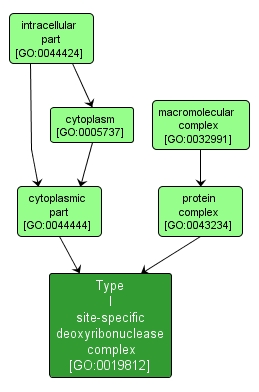| Desc: |
A multisubunit complex composed of two copies of a restriction (R) subunit, two copies of a methylation (M) subunit, and one copy of a specificity (S) subunit. This complex recognizes specific short DNA sequences (through the S subunit), and binds to them. If the recognition site is hemimethylated, the complex acts as a methyltransferase which modifies the recognition site, using S-adenosylmethionine as the methyl donor. Only the M and S subunits are required for this reaction. If the complex binds to an unmethylated recognition site, then the complex translocates the DNA bidirectionally in an ATP-dependent manner. When the translocation is stalled by impact with another complex or unusual DNA structure, the enzyme functions as an endonuclease and cleavage of the DNA will occur, hundreds or thousands of base pairs away from the recognition site. These DNA restriction systems are used by bacteria to defend against phage and other foreign DNA that may enter a cell. |














